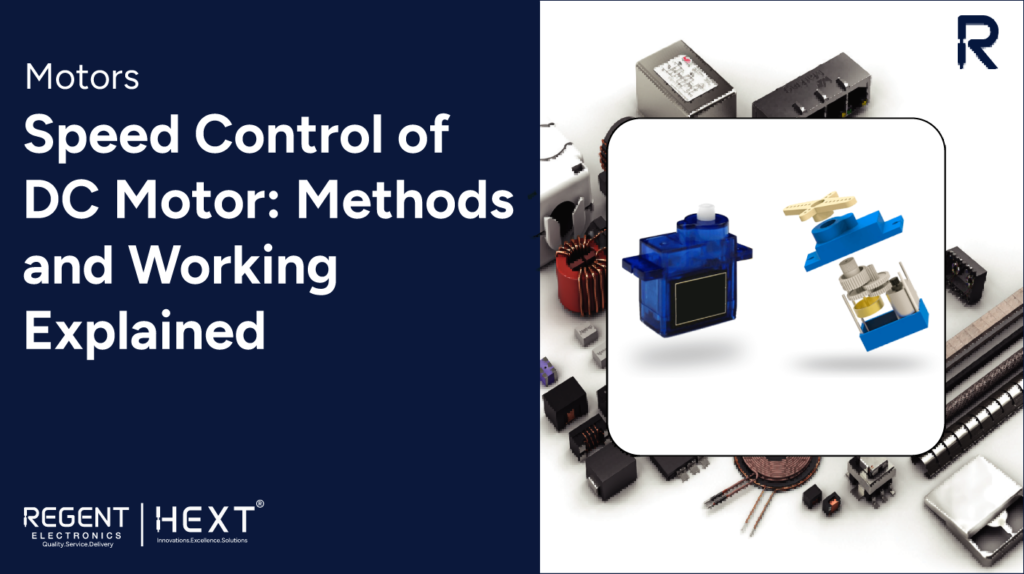
Speed Control of DC Motor: Methods and Working Explained
DC motors are widely used in various industries and DIY projects due to their ability to provide precise control over speed and direction. From robotic vehicles and elevators to paper mills and conveyor belts, speed control of a DC motor plays a crucial role in modern motion systems.
In this article, Regent Electronics breaks down the different methods of controlling DC motor speed, explaining the concepts in a simple and effective manner.
🧲 What is a DC Motor?

A DC motor is an electromechanical device that converts direct current (DC) electrical energy into mechanical motion. It operates based on Lorentz Law, which states that a current-carrying conductor placed in a magnetic field experiences a mechanical force.
⚙️ What is Speed Control of DC Motor?

Speed control refers to the intentional regulation of a DC motor’s rotational speed. This can be done either manually or using an automatic control system. Unlike speed regulation (which deals with maintaining speed despite load changes), speed control allows dynamic adjustment based on user input or system requirements.
📐 DC Motor Speed Formula
The speed of a DC motor (N) is given by:
N = K × (V – Ia × Ra) / Φ
Where:
- N = Speed of the motor
- K = Constant
- V = Applied voltage
- Ia = Armature current
- Ra = Armature resistance
- Φ = Magnetic flux
From this, we can conclude:
- Speed increases with supply voltage
- Speed decreases with armature resistance
- Speed decreases with an increase in magnetic flux
🔧 Methods of DC Motor Speed Control
There are three primary methods to control the speed of a DC motor:
1️⃣ Flux Control Method

This method involves adjusting the magnetic flux (Φ) generated by the field winding. Since magnetic flux is proportional to the current flowing through the field winding, speed can be controlled by varying that current using a variable resistor in series.
How it works:
- Initially, minimal resistance allows rated current and normal speed.
- Increasing resistance reduces current and magnetic flux.
- Lower flux causes the motor speed to increase beyond its normal range.
Best for: Applications requiring speeds higher than rated speed.
2️⃣ Armature Control Method

Here, speed is controlled by varying the voltage across the armature using a series resistor.
How it works:
- When resistance is low, the motor operates at rated speed.
- Increasing the series resistance lowers the voltage across the armature.
- Reduced voltage means reduced speed.
Note: This method results in power losses due to heat dissipation in the resistor and is generally used for speeds below the rated range.
3️⃣ Voltage Control Method

This is a more efficient and versatile method, offering a broader speed range without the disadvantages of the previous two.
How it works:
- The field winding receives a fixed voltage.
- The armature receives a variable voltage using different techniques:
- Switchgear-based voltage control
- Ward-Leonard System: An AC motor drives a DC generator that powers the motor
- Pulse Width Modulation (PWM)
⚡ PWM – Pulse Width Modulation (Most Recommended)
PWM is the most commonly used technique for precise and energy-efficient DC motor speed control.
How it works:
- A series of variable-width pulses are sent to the motor driver IC.
- The microcontroller (such as Arduino or STM32) adjusts pulse width based on input (like push buttons or sensors).
- Wider pulses mean more average voltage and higher speed, while narrower pulses lower the speed.
Advantages of PWM:
- High efficiency with minimal power loss
- Easy to implement with microcontrollers
- Smooth and precise speed adjustment
🧠 Conclusion
Controlling the speed of a DC motor is a critical aspect of automation, robotics, and industrial systems. Depending on the requirements — whether it’s speed above or below rated, efficiency, or system complexity — different control methods can be applied.
At Regent Electronics, we provide everything you need to build or upgrade your DC motor system, from motor drivers to development boards and control modules.
